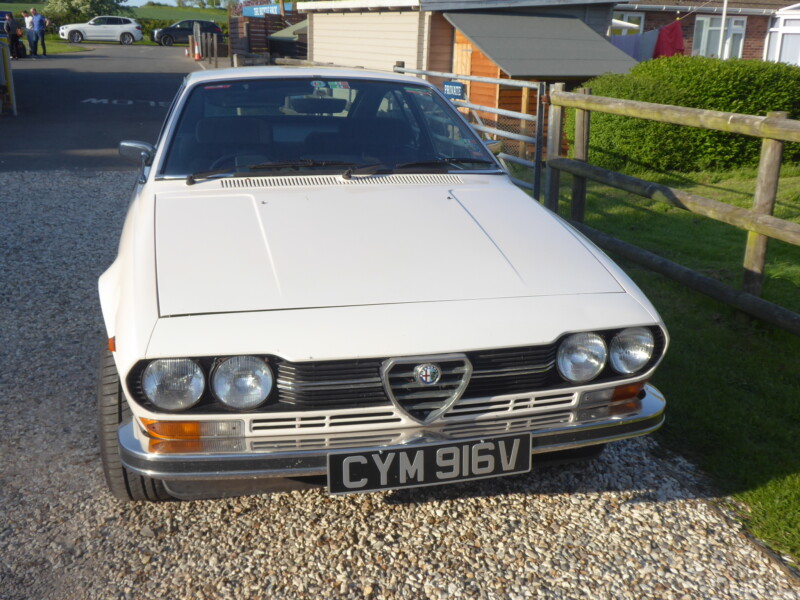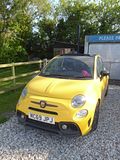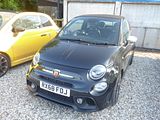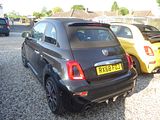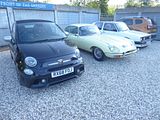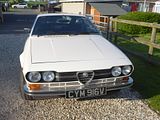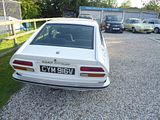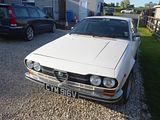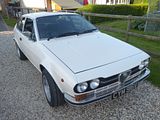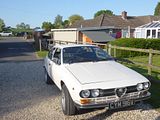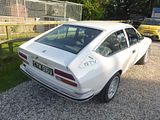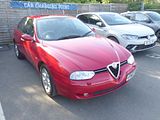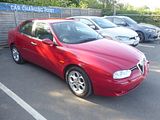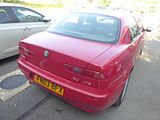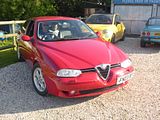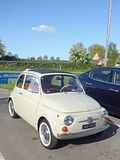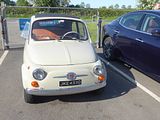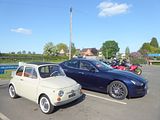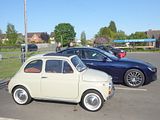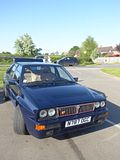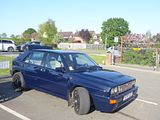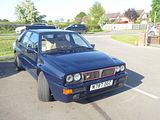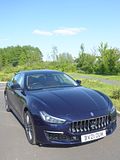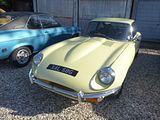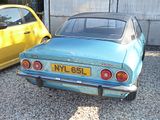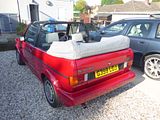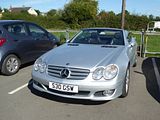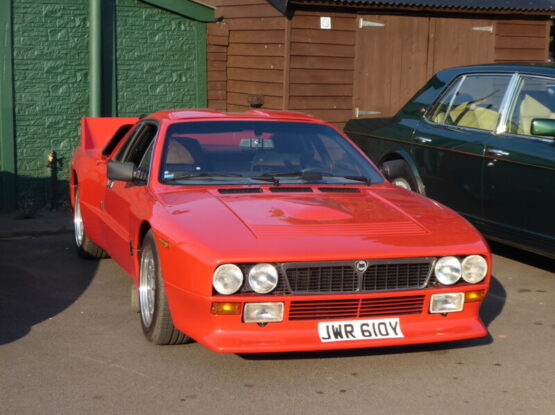Like so many newly opened venues I became aware of this one from posts I saw on social media from people who had visited. Gilks Café is situated in the Warwickshire village of Kineton, just a few miles away from the much better known British Motor Museum at Gaydon, and also only a bit further away from Caffeine & Machine. Indeed, many of those posts were from people who had decided that they wanted somewhere different after having maxxed out on their Caffeine & Machine experiences, and this seemed to fill the bill. With a history of a business going back to 1904 and through five generations of the same family. the Café is based in a former village car showroom, and there is plenty of memorabilia inside to remind everyone of the days when this was the place to come for your Rootes Group car. Now, though, it is a bustling café serving breakfasts, coffee/tea and home cakes. Word quickly got out that the food here is quality and so the venue has already become popular. It attracts lots of bikers, both of the motorised and self-propelled sort and often these can occupy a significant part of the limited car parking as the riders get suitable refreshment here. And indeed, car parking is the limiting factor for this venue, with no more than 20 places available in front of the café or around the back, though I understand that in summer months there is an arrangement to use the field across the roads as an overflow. The venue is open five days a week and usually closes during mid- afternoon but does do private openings for Clubs, and the Abarth West Midlands group enjoyed a pizza evening there earlier in the year. Sadly, I missed that, as I was on holiday, but when I saw that they were going to host an Italian evening, and the logistics of my diary worked, I decided to go along.
ITALIAN CARS
No-one knew quite how many cars would turn up, and although it was a lovely sunny afternoon, the answer turned out to be “not many”, but at least that meant there was parking for everyone, and I was able to talk to the owners of all the cars during the evening.
Abarth 595C: What is known as the Series 4 version of the familiar 595 reached the markets in the middle of 2016. After rumours had circulated all winter following the launch of the facelifted Fiat 500 last year, Abarth finally unveiled the Series 4 at the end of May 2016. Initially, we were told that the cars would not be available in the UK until September, but that came forward somewhat, with dealers all receiving demo cars in June, and the first customers taking delivery in July. Three regular production versions of both the closed car and the open-topped C were initially available, all badged 595, and called Custom, Turismo and Competizione, as before, though numerous limited edition models have since appeared and in most case disappeared. The most significant changes with the Series 4 are visual, with a couple of new colours, including the much asked for Modena Yellow and a different red, called Abarth Red, which replaces both the non-metallic Officina and – slightly surprisingly – the tri-coat pearlescent Cordolo Red. as well as styling changes front and rear. The jury is still out on these, with many, me included, remaining to be convinced. At the front, the new air intake does apparently allow around 15 – 20 % more air in and out, which will be welcome, as these cars do generate quite a lot of heat under the bonnet. Competizione models for the UK retain the old style headlights, as they have Xenon lights as standard, whereas the Custom and Turismo cars have reshaped units. At the back, there are new light clusters and a new rear bumper and diffuser. Inside, the most notable change is the replacement of the Blue & Me system with a more modern uConnect Audio set up, which brings a new colour screen to the dash. Mechanically, there is an additional 5 bhp on the Custom (now 145) and Turismo (now 165 bhp) and the option of a Limited Slip Diff for the Competizione, which is likely to prove a popular option. Details of the interior trim have changed, with a filled-in glovebox like the US market cars have always had, and electric windows switches that are like the US ones, as well as a part Alcantara trim to the steering wheel in Competizione cars.
Alfa Romeo Alfetta GTV: As was still the practice in the 1970s, Alfa followed up the launch of the Alfetta Berlina with a very pretty coupe. Styled by Giugiaro, this car, initially called the GT, and premiered in the autumn of 1974, looked completely unlike the saloon on which it was based. The first cars had 1.8 litre four cylinder engines and there was one of those on show. In 1976 the range was expanded both up and down with a 1.6 and a 2.0 model, the latter adopting the legendary GTV name. A rare SE model from this period was part of the display, complete with period vinyl roof (look closely), and although the pain does appear a bit like a lot of older Alfa reds, having gone rather pink, this was the actual shade when the car was new. In 1981, with the 2.5 litre V6 engine that had been developed for the ill-fated Alfa 6 luxury saloon available, Alfa was able to create a true rival for the 2.8 litre Capri with the GTV6. A facelift modernised the look of the car with plastic bumpers front and rear and a new interior looked rather better as well as being more ergonomically logical. There was a good mix of the earlier chrome bumpered and later plastic bumpered models, the last with 2.0 and 2.5 GTV6 versions both represented. There was also a car sporting 3.0 badging and right hand drive. This is a South African car. From 1974 South African Alfetta’s were manufactured at Alfa Romeo’s own Brits plant. South Africa was one of two markets to have a turbocharged GTV6, with a Garrett turbocharger and a NACA intake. An estimated 750 were assembled before all production ceased in 1986. The South African range included a 3.0 litre GTV-6, predating the international debut of the factory’s 3.0 litre engine in 1987 (for the Alfa 75). and 212 of these were built in South Africa for racing homologation. The last 6 GTV-6 3.0’s were fuel injected. To this day, the GTV-6 remains the quintessential Alfa Romeo for South Africans.
Alfa Romeo 156: When the 156 was launched in 1997, things looked very bright for Alfa. Striking good looks were matched by a driving experience that the press reckoned was better than any of its rivals. The car picked up the Car of the Year award at the end of the year. and when it went on sale in the UK in early 1998, waiting lists soon stretched out more than 12 months. Reflecting the way the market was going, Alfa put a diesel engine under the bonnet, launched a (not very good, it has to be admitted) automated transmission with the SeleSpeed, added a very pretty if not that commodious an estate model they called Sport Wagon and then added a top spec 3.2 litre GTA with its 250 bhp engine giving it a performance to outrun all its rivals. And yet, it did not take long before the press turned on the car, seduced by the latest 3 Series once more, citing build quality issues which were in fact far from universal. The 156 received a very minor facelift in 2002 and a more significant one in late 2003 with a new front end that was a clue to what would come with the car’s successor. Production ceased in 2005.
Fiat “Nuova” 500D: Known as project 110, the brief for the Nuova 500 was to create a micro-car that would not only carry on the tradition of the earlier Topolino, but which would also take sales away from the ever popular Lambretta and Vespa scooters of the day. It clearly needed to be smaller than the 600 which had been released with a conventional 4 cylinder engine. Not an easy task, but development started in 1953 and by August 1954, two designs were ready to be shown to Fiat management. They selected one, and serious development began. At first the car was referred to as the 400, as it was going to have a 400cc engine, but it was soon realised that this was just too small, so a larger 500cc air-cooled engine was developed. It was signed off in January 1956, with production starting in March 1957 in advance of a June launch. Fiat’s marketing department got busy, with hundreds of the new car taking to the streets of Turin, each with a pretty girl standing through the open sunroof that was a feature of all the early cars. The press loved it. 50 units were shipped to Britain, where the car made its debut at Brands Hatch, and again the reception was enthusiastic. But the orders just did not come in. Fiat went for a hasty rethink, relaunching the car at the Turin Show later that year. power was increased from 13 to 15 bhp, and the poverty spec was lessened a little, with headlight bezels, brightwork on the side and chrome hubcaps, a Nuova500 badge on the engine cover, winding side windows (the launch cars just had opening quarterlights) and the option of a heater fan. It was enough to get sales moving. The original car was still offered, at a lower price, called the Economy. In the first year of production, 28,452 Fiat 500s were made. Over the next 19 years, the car changed little in overall appearance, but there were a number of updates with more power and equipment added. A 500 Sport was launched in August 1958, with a more powerful version of the 499cc engine. It lost the soft top, having a ridged steel roof, to increase strength of the body. It was only available in grey with a red side flash. The first major changes came in 1960 with the 500D. This looks very similar to the Nuova, but with two key differences. One is the engine size: the D features an uprated 499 cc engine producing 17 bhp as standard, an engine which would be used right through until the end of the L in 1973; and the other is the roof: the standard D roof does not fold back as far as the roof on the Nuova, though it was also available as the “Transformable” with the same roof as the Nuova. The D still featured “suicide doors”. There were larger rear light clusters, more space in the front boot thanks to a redesign of the fuel tank and new indicators under the headlights. A year later, Fiat added a light on the rear-view mirrors and a windscreen washer, but the car still lacked a fuel gauge. Sales increased from 20,900 in 1960 to 87.000 in 1961, 132,000 in 1962 and by 1964, the last year of production, they hit 194,000 units. The D was replaced in 1965 by the 500F, which finally moved the door hinges from back to the front, owing to changes in Italian safety laws. There was a deeper windscreen and thinner door pillars, which increased the height of the car by 10mm, improving visibility for the driver. The 500F ran through to 1975, from 1968 alongside the more luxurious 500L which was added to the range in 1968. The L is easy to tell apart, with its bumper overriders. The final updates created the 500R, which incorporated many changes from the 126 under the skin of the classic shape, and in this form production continued alongside the newer 126 until 1976.
Lancia Delta Integrale: Lancia launched the Delta in 1979, as what we would now think of as a “premium hatch”. Offered in 1300 and 1500cc engines, this car, which collected the prestigious “Car of the year” award a few months later, brought Italian style and an expensive feeling interior to a new and lower price point in the market than Lancia had occupied since the early days of the Fulvia some 15 years earlier. The range grew first when a model was offered using the 4 speed AP automatic transmission and then in late 1982, more powerful models started to appear, with first a 1600cc engine, and then one with fuel injection, before the introduction of the HF Turbo. All these cars kept the same appearance and were quite hard to tell apart. These were the volume models of the range, but now they are very definitely the rare ones, as it is the performance versions which have survived and are now much loved classics, even though relatively were sold when they were new, thanks to a combination of the fact that they were quite costly and that they only ever came with left hand drive. The Integrale evolved over several years, starting off as the HF Turbo 4WD that was launched in April 1986, to homologate a new rally car for Lancia who needed something to fill the void left by the cancellation of Group B from the end of 1986. The Delta HF 4X4 had a four-wheel drive system with an in-built torque-splitting action. Three differentials were used. Drive to the front wheels was linked through a free-floating differential; drive to the rear wheels was transmitted via a 56/44 front/rear torque-splitting Ferguson viscous-coupling-controlled epicyclic central differential. At the rear wheels was a Torsen (torque sensing) rear differential. It divided the torque between the wheels according to the available grip, with a maximum lockup of 70%. The basic suspension layout of the Delta 4WD remained the same as in the rest of the two-wheel drive Delta range: MacPherson strut–type independent suspension with dual-rate dampers and helicoidal springs, with the struts and springs set slightly off-centre. The suspension mounting provided more isolation by incorporating flexible rubber links. Progressive rebound bumpers were adopted, while the damper rates, front and rear toe-in and the relative angle between springs and dampers were all altered. The steering was power-assisted rack and pinion. The car looked little different from the front wheel drive models. In September 1987, Lancia showed a more sophisticated version of the car, the Lancia Delta HF Integrale 8V. This version incorporated some of the features of the Delta HF 4WD into a road car. The engine was an 8-valve 2 litre fuel injected 4-cylinder, with balancing shafts. The HF version featured new valves, valve seats and water pump, larger water and oil radiators, more powerful cooling fan and bigger air cleaner. A larger capacity Garrett T3 turbocharger with improved air flow and bigger inter-cooler, revised settings for the electronic injection/ignition control unit and a knock sensor, boosting power output to 185 bhp at 5300 rpm and maximum torque of 224 lb/ft at 3500 rpm. The HF Integrale had permanent 4-wheel drive, a front transversely mounted engine and five-speed gearbox. An epicyclic centre differential normally split the torque 56 per cent to the front axle, 44 per cent to the rear. A Ferguson viscous coupling balanced the torque split between front and rear axles depending on road conditions and tyre grip. The Torsen rear differential further divided the torque delivered to each rear wheel according to grip available. A shorter final drive ratio (3.111 instead of 2.944 on the HF 4WD) matched the larger 6.5×15 wheels to give 24 mph/1000 rpm in fifth gear. Braking and suspension were uprated to 284 mm ventilated front discs, a larger brake master cylinder and servo, as well as revised front springs, dampers, and front struts. Next update was to change the engine from 8 valves to 16. The 16v Integrale was introduced at the 1989 Geneva Motorshow, and made a winning debut on the 1989 San Remo Rally. It featured a raised centre of the bonnet to accommodate the new 16 valve engine, as well as wider wheels and tyres and new identity badges front and rear. The torque split was changed to 47% front and 53% rear. The turbocharged 2-litre Lancia 16v engine now produced 200 bhp at 5500 rpm, for a maximum speed of 137 mph and 0–100 km/h in 5.5 seconds. Changes included larger injectors, a more responsive Garrett T3 turbocharger, a more efficient intercooler, and the ability to run on unleaded fuel without modification. The first Evoluzione cars were built at the end of 1991 and through 1992. These were to be the final homologation cars for the Lancia Rally Team; the Catalytic Evoluzione II was never rallied by the factory. The Evoluzione I had a wider track front and rear than earlier Deltas. The bodyside arches were extended and became more rounded. The wings were now made in a single pressing. The front strut top mounts were also raised, which necessitated a front strut brace. The new Integrale retained the four wheel drive layout. The engine was modified to produce 210 bhp at 5750 rpm. External changes included: new grilles in the front bumper to improve the air intake for engine compartment cooling; a redesigned bonnet with new lateral air slats to further assist underbonnet ventilation; an adjustable roof spoiler above the tailgate; new five-bolt wheels with the same design of the rally cars; and a new single exhaust pipe. Interior trim was now grey Alcantara on the Recaro seats, as fitted to the earlier 16V cars; leather and air conditioning were offered as options, as well as a leather-covered Momo steering wheel. Presented in June 1993, the second Evolution version of the Delta HF Integrale featured an updated version of the 2-litre 16-valve turbo engine to produce more power, as well as a three-way catalyst and Lambda probe. A Marelli integrated engine control system with an 8 MHz clock frequency which incorporates: timed sequential multipoint injection; self-adapting injection times; automatic idling control; engine protection strategies depending on the temperature of intaken air; Mapped ignition with two double outlet coils; Three-way catalyst and pre-catalyst with lambda probe (oxygen sensor) on the turbine outlet link; anti-evaporation system with air line for canister flushing optimised for the turbo engine; new Garrett turbocharger: water-cooled with boost-drive management i.e. boost controlled by feedback from the central control unit on the basis of revs/throttle angle; Knock control by engine block sensor and new signal handling software for spark park advance, fuel quantity injected, and turbocharging. The engine now developed 215 PS as against 210 PS on the earlier uncatalysed version and marginally more torque. The 1993 Integrale received a cosmetic and functional facelift that included. new 16″ light alloy rims with 205/45 ZR 16 tyres; body colour roof moulding to underline the connection between the roof and the Solar control windows; aluminium fuel cap and air-intake grilles on the front mudguards; red-painted cylinder head; new leather-covered three-spoke MOMO steering wheel; standard Recaro seats upholstered in beige Alcantara with diagonal stitching. In its latter years the Delta HF gave birth to a number of limited and numbered editions, differing mainly in colour, trim and equipment; some were put on general sale, while others were reserved to specific markets, clubs or selected customers.
Maserati Ghibli: Final Italian car was mine, and the only Maserati here.
NON ITALIAN CARS
There were a number of non Italian cars here as well, including a couple which I had seen at Caffeine & Machine a little earlier in the afternoon.
Jaguar E Type Series 2: The Series 2 E Type introduced a number of design changes, largely due to U.S. National Highway Traffic and Safety Administration mandates. The most distinctive exterior feature is the absence of the glass headlight covers, which affected several other imported cars, such as the Citroën DS, as well. Unlike other cars, this step was applied worldwide for the E-Type. Other hallmarks of Series 2 cars are a wrap-around rear bumper, larger front indicators and tail lights re-positioned below the bumpers, and an enlarged grille and twin electric fans to aid cooling. Additional U.S.-inspired changes included a steering lock which moved the ignition switch to the steering column, replacing the dashboard mounted ignition and push button starter, the symmetrical array of metal toggle switches replaced with plastic rockers, and a collapsible steering column to absorb impact in the event of an accident. New seats allowed the fitment of head restraints, as required by U.S. law beginning in 1969. The engine is easily identified visually by the change from smooth polished cam covers to a more industrial “ribbed” appearance. It was de-tuned in the US with twin two-barrel Strombergs replacing three SUs. Combined with larger valve clearances horsepower was reduced from 265 to 246 and torque from 283 to 263. Air conditioning and power steering were available as factory options. Production totalled 13,490 of all types, with 4885 of the FHC, 5,326 of the 2+2 and 8,628 of the OTS model.
Meyers Manx: The Meyers Manx dune buggy is a small recreationally-oriented automobile, designed initially for desert racing by Californian engineer, artist, boat builder and surfer Bruce F. Meyers. It was produced by his Fountain Valley, California company, B. F. Meyers & Co. from 1964 to 1971, in the form of car kits applied to shortened chassis of Volkswagen Beetles. The car line dominated dune racing in its time, breaking records immediately, and was eventually also released in street-oriented models, until the company’s demise due to tax problems after Meyers’s departure. New vehicles inspired by the original Manx buggy have been produced by Meyers’s re-founded operation, Meyers Manx, Inc., since 2000. The name and cat logo of the brand derives from the Manx cat, by virtue of the tailless breed’s and the shortened vehicle’s truncated “stubbiness”. Drawing on his experience in sailboat construction, Meyers modelled and built his first dune buggy, “Old Red”, a shortened VW Beetle with a monocoque, fiberglass shell and Chevrolet pickup truck (trailing arm style) suspension, in late 1963 to May 1964 in his garage in Newport Beach, California. The first known street-legal fiberglass dune buggy, it featured a unibody shell that fused body, fenders and frame, retaining just the engine, transmission and other mechanicals of the VW, and with no top and no hood. The use of compound curves throughout provided great rigidity. The fenders were arched high, to make room for large, knobby dirt-racing wheels. The “Manx” name for the shortened, taller-wheeled, more maneuverable VW Beetle mods refers to and derives from the comparably stubby Manx cat breed, colloquially called “stubbins”; they are short-spined and stub-tailed-to-tailless, long-legged, and known for their turning ability while chasing. The Meyers Manx logo prominently features a Manx cat. The tailless cat in the logo, as featured on the hood ornament, is stylized after a passant heraldic lion, its right forepaw brandishing a sword. The name also suggests racing fitness, as the already globally renowned, British-manufactured Norton Manx motorcycle dominated the Isle of Man TT, Manx Grand Prix and other Isle of Man-based (i.e. Manx) international races from the 1940s to the early 1970s. The Meyers Manx has no direct connection to the Isle of Man. Meyers produced kits later in 1964 and into 1965, marketed under the name Meyers Manx. Although this early design was critically acclaimed, even featured on the April 1967 cover of Car & Driver magazine, and drew much attention, it proved too expensive to be profitable; ultimately only 12 kits of the monocoque Manx were produced. Meyers and a friend (both amateur racers) broke by over four hours the Ensenada – La Paz run’s record of 39 hours, until then held by a pro racer. According to James Hale, compiler of the Dune Buggy Handbook, this feat ushered in an era of Meyers Manx “domination in off-road events … and the formation of NORRA (National Off-Road Racing Association)”. The commercially manufactured Meyers Manx Mk I featured an open-wheeled fiberglass bodyshell, coupled with the Volkswagen Beetle H4 flat-four engine (1.2 L, 1.3 L, 1.5 L and 1.6 L, in different models) and a modified, RR-layout Beetle frame. It is a small car, with a wheelbase 14¼ inches (36.2 cm) shorter than a Beetle automobile for lightness and better maneuverability. For this reason, the car is capable of very quick acceleration and good off-road performance, despite not being four-wheel drive. The usually street-legal car redefined and filled a recreational and competitive niche that had been essentially invented by the first civilian Jeep in 1945, and which was later to be overtaken by straddle-ridden, motorcycle-based all-terrain vehicles (introduced in 1970) and newer, small and sporty (but usually four-wheel-drive), off-road automobiles. The commercial Meyers Manx received widespread recognition when it defeated motorcycles, trucks and other cars to win the inaugural 1967 Mexican 1000 race (the predecessor of the Baja 1000). It crossed automotive press genre lines, being selected as the cover story in the August 1966 issue of Hot Rod magazine. Approximately 6,000 of the original Meyers Manx dune buggies were produced, but when the design became popular many copies (estimated at a quarter of a million worldwide) were made by other companies. Although already patented, Meyers & Co. lost in court to the copiers, the judge rescinding his patent as unpatentable, opening the floodgates to the industry Meyers started.[citation needed] Since then, numerous vehicles of the general “dune buggy” or “beach buggy” body type, some VW-based, others not, have been and continue to be produced. An early example was the Imp by EMPI (1968–1970), which borrowed stylistic elements from the Chevrolet Corvette but was otherwise Manx-like. A later 1970s Manx clone was the Dune Runner from Dune Buggy Enterprises in Westminster, California. The Meyers company attempted to stay ahead of this seemingly unfair competition with the release of the distinctive, and harder-to-copy, Meyers Manx Mk II design. B. F. Meyers & Co. also produced other Beetle-based vehicles, including the May 1970 Car & Driver magazine cover sporty Manx SR variant (street roadsters, borrowing some design ideas from the Porsche 914), the Meyers Tow’d (sometimes referred to as the “Manx Tow’d”, a non-street-legal racing vehicle designed to be towed to the desert or beach), the Meyers Tow’dster (a street-legal hybrid of the two, and Meyers Resorter a.k.a. Meyers Turista (a small recreational or “resort” vehicle inspired by touring motorcycles). The Manx SR2 was a modified SR that was only produced by later manufacturers including Karma Coachworks, Heartland Motors and Manx Motors of MD. While the Tow’d was a minimal off-road racer and the SR/SR2 was a showy roadster, the Tow’dster was a compromise between a dune-capable vehicle and a more utilitarian street rod, and “paved the way for the rail-type buggy that was to dominate the buggy scene following the demise of the traditional Manx-type buggy.” The company ceased operation in 1971, after financial troubles, including with the Internal Revenue Service and Bruce Meyers himself had already left his own company by then.
Opel Manta A: There were two distinct generations of Manta, the car that Opel conceived to compete against the Ford Capri. The Manta A was released in September 1970, two months ahead of the then new Opel Ascona on which it was based. A competitor to the Ford Capri, it was a two-door “three-box” coupé, and featured distinctive round tail lights, quite similar to those on the Opel GT and which in fact were used on the GT in 1973, its final model year. It took its name, and a few minor styling cues, from the Manta Ray concept car (1961), which also famously influenced the 1968 Chevrolet Corvette C3 (both Chevrolet and Opel have General Motors as their parent company). The only difference between the Ascona and Manta was exterior sheet metal, glass and trim. The frame, mechanics, dash, front seats, and many other parts were shared between the cars. The Manta was normally equipped with a 1.6 or a 1.9-litre CIH engine, although in Europe, a small 1.2-litre motor was also offered. All Mantas sold in the U.S. had the 1.9 L and larger heavy duty radiator (an option on European models). It came with either a four-speed manual or a three-speed TH-180 automatic. The Manta was known to be one of the best-handling cars in its class and went on to win a large number of rallies in Europe and the United States. There was a sport model known as the “Rallye” from 1971 to 1974. The Rallye model was, overall, an appearance and gauge package, the most noticeable difference being the addition of a black bonnet, and on 1970–1973 models, fog lamps. Mechanically, the only difference was the gear ratios in the models with manual transmissions, and the Rallye model came with standard stiffer suspension, a tighter turning radius, and very aggressive front caster adjustments. Both had dual rear anti-roll bars, providing exceptional handling. In 1973 and 1974 there was also the “Luxus” model, which included refinements like corduroy seats, colour-coded interiors (blue or burgundy), and faux wood panelling. The only special edition Manta ever produced for the U.S. market was the “Blue Max”, in 1973. This amounted to a blue 1973 Luxus model, with a unique dark blue vinyl roof, mechanical sunroof, and automatic transmission. The European market had a number of different versions. Most were basic trim packages, the most popular being the “Berlinetta”, which was similar to the Luxus but included rubber trim on the bumpers (standard on all 1973 U.S. Opel Mantas), vinyl roof, and other miscellaneous features. The one exception was the 1975 Opel, which offered the GT/E and a number of special editions based on the GT/E. The GT/E was a fuel-injected version of the European 1.9L and the performance figures were very impressive for the time. The most notable special editions models based on the GT/E were the “Black Magic” (with black and plaid interior) and the “Swinger” edition in white, also with an odd interior choice.
VW Golf Cabriolet: Conceived as a replacement for the popular Beetle Cabrio, and at the time unique in the market place, a convertible version of the Golf was presented to Volkswagen’s management by coachbuilder Wilhelm Karmann GmbH as early as 1976. This early prototype lacked the roll-over bar of the later version, and had a flat body line in the rear, where the soft top folded down below the sill level. The production version of the convertible Golf was designated Type 155. In Europe and Canada it was called the Golf Cabriolet, while in the United States it was sold as the Rabbit Convertible until 1985, when it was also renamed “Cabriolet”. The Cabriolet was sold from 1980 to 1993. It had a reinforced body, a transverse roll-over bar, and a high level of trim. From stamping to final assembly the Mk1 Cabriolet was built entirely at the Karmann factory. Volkswagen supplied engines, suspension, and interior trim for Karmann to install. The tops, of vinyl or cloth, were heavily insulated, with a heated glass rear window. The top was raised and lowered manually until 1991, when it became electrically operated. The body of the Cabriolet did not change through the entire production run except for a larger fuel tank. It kept the pre-1980 style of rear lamp clusters. A space saver spare wheel was fitted from the outset, including 1978 pre-production models, unlike the saloon which did not adopt this until 1984. All Cabriolets from 1988 on left the factory fitted with a “Clipper” bodykit that featured smooth body-coloured bumpers, wheel-arch extensions, and side skirts. Prior to the 1984 model year the highest standard specification Cabriolet was the GLI, which was essentially a GTI in all but name. It was only in late 1983 with the introduction of the 1984 model that an officially badged GTI version of the cabriolet finally became available.
AND A PREVIOUS VISIT
This was not actually my first visit, as I had popped by the previous autumn, when in the area, and curious to see what the place was like, before heading over to Caffeine & Machine. On that occasion, there were lots of bikes there and rather more tight-fitting lycra on show than I really wanted to see (!), but I was able to enjoy a a good quality breakfast for a reasonable price. The only car of note, really, was this one:
Mercedes SL (R230): The R230 generation of the Mercedes-Benz SL-Class was introduced at the 2001 Frankfurt Motor Show and 2001 Bologna Motor Show, replacing the R129. The R230 underwent revisions in 2006 and 2008, and was superseded by the new SL-Class R231 in 2011. In early 1996, over six years into the life of the R129, development work on a successor began. On 27 January 1996, design work commenced and draft designs were submitted from ten designers in Germany, California, and Japan. Hundreds of sketches were submitted and would form the basis for twelve quarter scale models which were digitized for computer manipulation. Design of the R230 would progress through two different formats. The real world process centered on the traditional 1:4 scale models, with most of them initially being done clay. Virtual world design development took place in a room packed with state-of-the-art computer processing technology referred to as the “CAVE” (Computer Aided Virtual Environment). This technology was also used earlier on to design the W203 in 1995. The supercomputer in the “CAVE” was able to create full-size images of selected designs, using its five projectors and allowing designers to inspect every inch of every surface rendered. Parallel to the virtual process, the twelve scale models were scrutinized as well, with four standouts chosen to be created in full-size mockups. This evolution of the scale models occurred alongside the development of the interior design. On 16 June 1997, the final design for the R230 was approved by the board and refined into production specifications into 1998. The design patents for the R230 were later filed in Germany on 9 September 1999 and on 1 March 2000 in the United States. In July 2001, after over five years of development, the new SL was unveiled and introduced at the 2001 Frankfurt Motor Show that September. Production began on 13 October 2001 at the Bremen plant and European sales commenced that November. This car first appeared as the Safety Car for Formula One at the 2001 German Grand Prix in Hockenheim. The street version was unveiled at the 2001 IAA. The range was launched with a film style advertisement called Lucky Star. Tthe range soon grew from the initial SL350 and Sl500 to include the V12 engined SL600 and SL55 AMG and SL65 AMG models, this last offering 612 PS. The SL underwent a facelift in 2006, and was unveiled at the 2006 Geneva Motor Show. Changes include new engines for SL 350 and SL 500 (called SL 550 in North America), with improved performance on SL 55 AMG and SL 600, as well as a new top-of-the-line SL 65 AMG. ABC (Active Body Control) was improved to reduce body movements in dynamic driving by up to 60%, standard on all models except the SL 350. The new engines were mated to a new 7-speed 7G-Tronic automatic, with a Sport option to allow shifting to be performed up to 30% faster in manual “M” mode, and with added steering-wheel shift paddles. Exterior styling changes include a new bumper with three large cooling air intakes and a more pronounced V-shape as well as fog lamps with chrome surrounds, new light-alloy wheels, new rear light. Interior changes include softer leather upholstery, new interior colours, high-quality metal door sills with Mercedes-Benz lettering and embossed aluminium trim elements, removable luggage cover, optional remote boot-lid release. The roof opening mechanism was also revised, reducing the opening time from 20 seconds to 16 seconds. With the 2007 model year, there was a limited production model (550 units) introduced to celebrate the 50th Anniversary of the SL roadster model. This Anniversary Edition version came with a pewter metallic exterior, cognac brown leather interior with black ash wood trim, 382 hp V8, exclusive twin-spoke rims, custom luggage bag for rear shelf, and many other standard options and features. The facelifted SL model was revealed in the Geneva Motor Show in March 2008. The SL received a new, more aggressive front end reflecting Mercedes’s new design philosophy, with a pair of long powerdomes on the bonnet and a single-bar grille replacing the old three-bar effort. Improvements have been made also on the engines. The 3.5 L V6 is uprated to 307 bhp at 6500 rpm. Compared to the previous 3.5-litre engine, the output has been boosted by 16 percent. Torque has also been improved adding 10 Nm (7.4 lb/ft) to the previous 350 Nm (258 lb/ft) making it 360 Nm (266 lb/ft). This engine now can rev up to a max of 7200 rpm for a period as the oil temperature and other engine parameters permit, a higher compression ratio, a new intake manifold and featuring extensive modifications to and lightening of the valve train. In this case, however, the extra power does not come at the expense of fuel economy: with a consumption figure of 9.9 l/100 km, the new SL 350 undercuts the previous model developing 272 PS by 0.4 l/100 km. Mercedes-Benz is extending the SL-Class line-up by introducing an attractive entry-level model in the shape of the SL 280 developing 231 PS. The six cylinder powerplant delivers its peak torque of 300 Nm (221 lb/ft) from 2500 rpm and accelerates the roadster from 0 to 100 km/h (62 mph) in 7.8 seconds, whilst fuel consumption (NEDC) is just 9.4 L/100 km (30 mpg‑imp; 25 mpg‑US). It features the AIRSCARF heating system used in the SLK. The R221 generation cars arrived to replace the model in 2011.
No question, this is a very pleasant venue, with some interesting memorabilia and a kitchen that turns out quality food, whether that be a plate of breakfast or some of the excellent cakes. The owner is a real enthusiast and is always keen to host Clubs, so it’s definitely a place I will be planning to revisit before too long.

